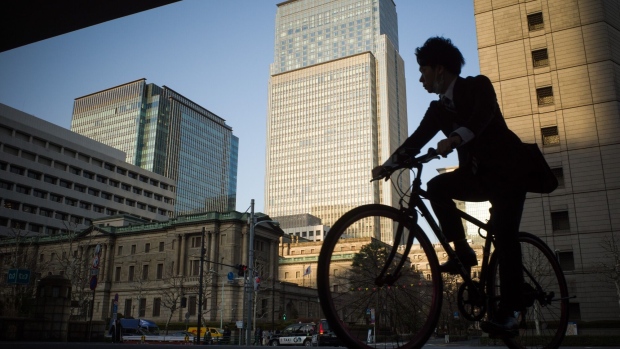Nov 1, 2023
Bank of Japan Steps Into Bond Market to Slow Rising Yields
, Bloomberg News

(Bloomberg) -- The Bank of Japan stepped into the bond market unexpectedly Wednesday to curb the pace of gains in sovereign yields, just a day after announcing it was loosening its grip on debt prices.
The central bank’s unscheduled purchase operation statement came as the benchmark 10-year bond yield touched 0.97% — a fresh decade-high but still below the 1% cap it removed in favor of a more flexible policy setting.
There was very little immediate market reaction to the move, with traders trimming one basis point off the 10-year yield before it recovered half of that. Bond futures pared losses and the yen, which is sensitive to shifts in interest rates, shed a fraction of its advance versus the dollar.
The buying operation suggests that even after tweaking its bond-yield cap, the BOJ is determined to demonstrate that it will remain active when the market moves significantly. Governor Kazuo Ueda said Tuesday after announcing his policy tweak that he didn’t expect yields to rise much beyond 1%.
Still, many analysts see the bigger picture as one in which the BOJ is stepping toward normalizing its monetary policy to respond to inflation in Japan that’s near a four-decade high. Shifting policy to make it less out of step with more hawkish stances maintained by other central banks is also seen as key to addressing an overly weak yen.
“Although the BOJ took action to discourage rises in yields, market players probably want to see the long-term yield reaching 1%,” said Keisuke Tsuruta, a senior fixed-income strategist at Mitsubishi UFJ Morgan Stanley Securities Co. Like the last time it tweaked yield-curve control in July, the central bank probably wants to make a pre-emptive move before a closely-watched 10-year bond auction tomorrow, he said.
The BOJ pulling back from the debt market, where its ownership of outstanding bonds has surpassed 50%, may pave the way for investors to become more active participants. Global market players are closely watching whether rebounding yields prompt Japanese investors to bring funds back home and sell down their huge holdings in everything from US Treasuries to bonds from Europe and Australia.
The 10-year yield was just 0.44% on July 27, one day before Ueda made his first tweak to yield-curve control.
--With assistance from Naoto Hosoda and Masahiro Hidaka.
©2023 Bloomberg L.P.






